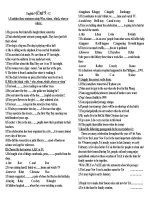unit 14-read
Bạn đang xem bản rút gọn của tài liệu. Xem và tải ngay bản đầy đủ của tài liệu tại đây (1.64 MB, 25 trang )
Period 85:
Welcome
- honor(v):
Unit 14: Lesson 1: A1-3/ p.140-141
I. Vocabulary:
- compile(v): Biªn tËp
- claim(v): Tuyªn bè
T«n kÝnh, kÝnh träng
- religion(n): T«n gi¸o
Matching
The Statue of Christ
The Great Wall of China
The Pyramid
Angkor Wat
True-False Statements Prediction
STATEMENTS
I think I read
1.The only surviving wonder is the
Pyramid of Cheops in Egypt.
2. Today, we can still see the Hanging
gardens of Babylon in present-day Iraq
3. The great wall of China first was not
in the list of the seven wonders of the
world.
4. In the early 15th century, the Khmer
King chose Angkor Wat a new capital.
Unit 14 Wonders of the world - Read
Centuries ago in Ancient Greece, a man by the name of Antipater of Sidon
compiled a list of what he thought were the seven wonders of the world. The
seven included the Hanging Gardens of Babylon in present-day Irag, The statue of
Zeus in Greece, and the Pyramid of Cheops in Egypt. The pyramid is the only
wonder you can still see today.
Many people claim that there were other wonders, which the ancient Greeks knew
nothing about. These include the Great Wall of China, the Taj Mahal in India and
Angkor Wat in Cambodia.
Angkor Wat should be known as a wonder because it is the largest temple in the
world. The temple was built around the year 1100 to honor a Hindu God, but over
the next three centuries it became a Buddhist religious center. The area
surrounding the temple, Angkor Thom, used to be the royal capital city.
In the early 15th century, the Khmer rulers moved to Phnom Penh and Angkor was
quiet. It now is a famous tourist attraction.
True-False Statements Prediction
STATEMENTS
I think I read
1.The only surviving wonder is the
Pyramid of Cheops in Egypt.
2. Today, we can still see the Hanging
gardens of Babylon in present-day Iraq
3. The great wall of China first was not
in the list of the seven wonders of the
world.
4. In the early 15th century, the Khmer
King chose Angkor Wat a new capital.
T
F
T
F
a/Who compiled a list of seven wonders of
the world?
b/What wonder of the world can you still
see today?
c/Which is the largest temple of the world?
d/Why was Angkor Wat built?
e/Did the Khmer rulers move the capital to
Phnom Penh in the early 15th century?
Comprehension questions
Rule of the game
We have 10 numbers
- One knock out number. You will lose all
your points if you choose it.
- Three lucky numbers .You will have 2
points and a chance to choose another
number if the number is lucky.
- Four questions. You will have to answer
them. The points depend on each
question.
- Two Miss a turn numbers. You will miss
your turn
1 2 3 4 5
6 10987
.
3 points
a/Who compiled a list of seven wonders
of the world?
b/What wonder of the world can you
still see today?
The meeting between William
Boyce and a scout (a boy) in
London.
4 points
They are the Girls Guides Association and the
coeducational Camp Fire Boys and Girls.
3 points
c/Which is the largest temple of the world?
d/Why was Angkor Wat built?
The three aims
are: build
character,
encourage good
citizenship and
personal fitness.
3 points
e/Did the Khmer rulers move the capital
to Phnom Penh in the early 15th
century?
At the end of the
conversation,
Nga asked her
grandmother to
tell her an old
folktale.
4 points
Miss a turn
Lucky number
2 points
Miss a turn
Lucky number
2 points
Lucky number
2 points
Knock out
Knock out
Learn new words by heart.
-Compare
Homework









